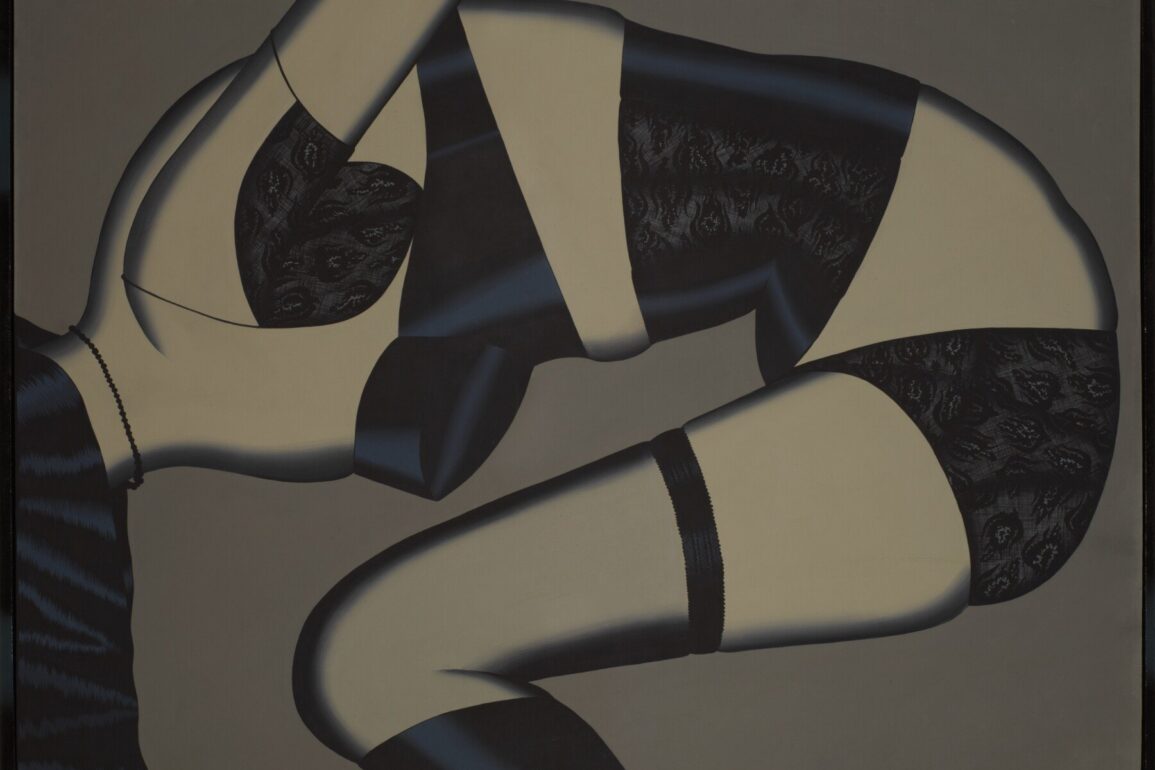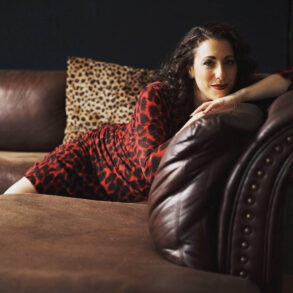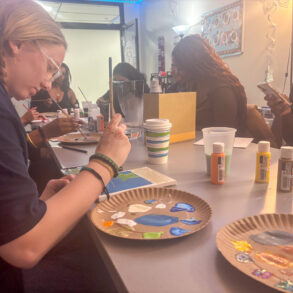In October 1969, during a festival on the grounds of Mount St. Francis Seminary in southern Indiana some ten miles upland from the Ohio River, a young nun killed herself by leaping into a bonfire. Witnesses recalled that she appeared to be in good spirits that day. Nobody could fathom her motive. Sister Carolina Mary simply shucked her shoes and sweater and plunged into the flames.
The artist Christina Ramberg, a recent graduate of the School of the Art Institute of Chicago, read about this incident in the newspaper and made a little sketch of the scene. “For a while I’ve been thinking about some paintings I’d like to make, but I’ve tried to ignore the thoughts because the paintings sound so sick,” she confided in her diary. What was it about the nun’s story that intrigued her? From our vantage more than a half-century on, the enticements are obvious: a woman in extremis; the small, decorative ceremony of removing shoes and sweater; and the riddle of the final act—was it meant as renunciation or martyrdom? Finally, there’s the graphic brevity of the image itself: a nun in flames. Such a sight spoils the eye.
By then Ramberg had already embarked on a series of similarly potent images—less theatrical than a nun’s immolation, but exacting and provocative nonetheless. These paintings feature women afflicted with rashes or skin diseases, their faces obscured by a censoring hand or a dabbed handkerchief. Other paintings function like glossaries of hair—hair that’s knotted, wadded, loaved, lozenged, sausaged, lacquered, or crimped; hair that looks like topographical maps of an atomic hinterland, unnaturally lustrous; hair presented like bonbons in colored wrappers. In 1971, Ramberg began producing the paintings that still define her reputation. These works depict the bodies of women from the neck down, sheathed in Depression-era corsets, panties, and bustiers, frozen in tense, almost ritualistic postures. The paintings’ titles—Probed Cinch, Black Widow, Delicate Decline, Loose Beauty—trumpet their psychosexual allure.
Ramberg foraged for imagery in wig catalogs, medical illustrations, the personal ads of BDSM magazines, comic strips, Japanese prints, and medieval paintings. Her aesthetic, like that of her peers in the Chicago art scene of the late 1960s and early 1970s, fuses playful formalism with thematic subversion. The dominant motif is the morphology of the female body as manifest in fragments and undergarments. “Ramberg demonstrates how these garments segment the body into many parts, and demarcations, each adding to the body’s alienation to the culture’s ability to fetishize and eroticize its bondage,” the critic Carol Becker wrote in 1988, marking the occasion of a Ramberg retrospective at the Renaissance Society in Chicago. That show should have heralded Ramberg’s mid-career ascension; instead, it turned out to be a coda. In one of those cruel turns of fate that exposes god as a philistine, Ramberg died of Pick’s disease, a rare form of dementia, in 1995. She was forty-nine.
Ramberg has always hovered on the outskirts of minor fame. During her career, she was twice included in the Whitney Biennial and was represented by the maverick gallerist Phyllis Kind. In Chicago, where many of her fellow artists and former students still live, Ramberg is spoken of with a kind of glassy reverence, fandom cut with condolence. Everywhere else she flickers in and out of focus, in the collection of most major museums, yet rarely on view, or else tucked into group shows. Her work graced the cover of Artforum as recently as 2018, but, still, she has the glamor of a cult figure. A career-spanning retrospective at the Art Institute of Chicago, Ramberg’s first in almost thirty years, stages a go-for-broke canonization. The show—which travels next to the Hammer Museum in Los Angeles and then to the Philadelphia Museum of Art—recenters Ramberg as an artist whose work is an enthralling inquiry into mutability.
Included here are paintings, drawings, photographic slides documenting Ramberg’s travels, scrapbooks, and the quilts that were her mainstay after 1983, when, seized by self-doubt, she temporarily abandoned painting. Viewed together, these works indicate how unique Ramberg was in her milieu, both in a material sense (her understated palette, her use of meticulously smooth Masonite instead of canvas) and a thematic one (her fixation on the body and its perversities). To an extent not always legible in a retrospective, this show also dramatizes the process by which the crude matter of inspiration is converted into art. Ramberg’s preparatory sketches, her private annotations, her diaristic snapshots—such an archive is itself a testament to experiencing the world with an artist’s alchemical eye.
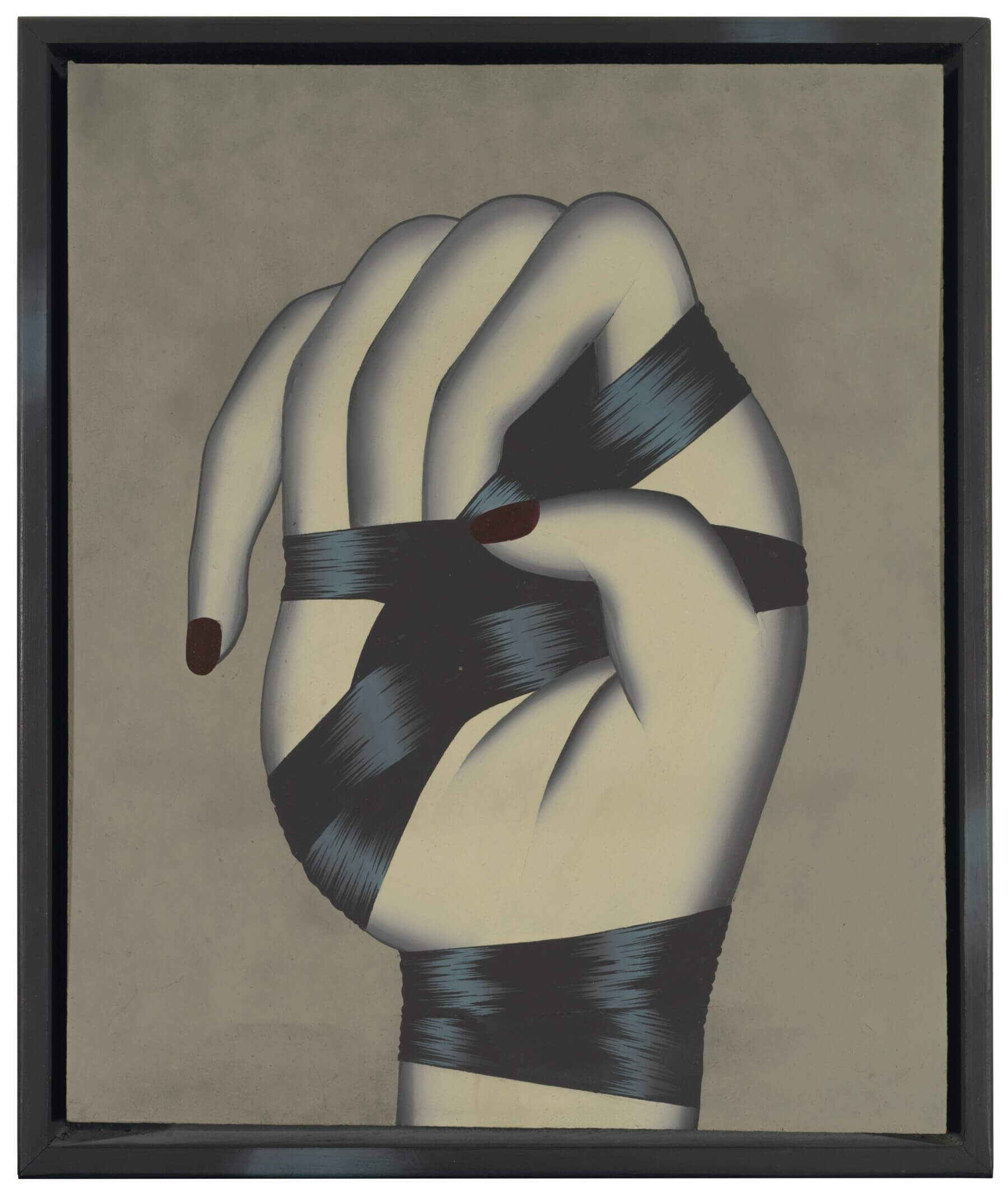
Ramberg was born in 1946 on a military base in Kentucky, where her army colonel father was stationed. When she was four, the family was transferred to Yokohama, which was still being rebuilt after the catastrophic firebombing of World War II. Other postings followed—in Germany, Kansas, and Virginia—before the family finally settled in suburban Chicago. Ramberg’s childhood was distinguished by an early aptitude for artmaking and a keen self-consciousness, and discomfort, around her body. Ramberg was tall, with disproportionately long limbs and oversized feet; she made her own clothes when she couldn’t find her size in stores. “She would get these catalogs in the mail, special catalogs for people with big feet. The shoes would look so pretty and cute. And then the shoes would come and they wouldn’t even look remotely like the catalog and she would cry,” Ramberg’s sister told the biographer Donna Seaman, who included a chapter about Ramberg in her book Identity Unknown: Rediscovering Seven American Women Artists.
In 1964, Ramberg enrolled at the School of the Art Institute of Chicago, where her instructors included Whitney Halstead, a noted art historian who urged his students to look beyond the Western canon, and Ray Yoshida, an artist whose own enigmatic cloaked figures and busily patterned backdrops were touchstones. Yoshida also introduced his students to Chicago’s Maxwell Street Market, a freewheeling outdoor bazaar where oddities and crafts—what Yoshida called “trash treasures”—could be scavenged on a budget. Collecting these objects was both a passionate vocation and the enactment of a shared aesthetic. Recognizing the beauty and psychic payload of curios that other bargain hunters overlooked was as much a philosophy of life as an artistic practice.
“The first reaction is very instinctive and spontaneous,” Yoshida said of his browsing. For him and his students, fine art had no supremacy over the castoffs that could be uncovered in flea markets or junk shops. Yoshida’s collection, which he constantly reshuffled throughout his apartment so as to coax forth novel juxtapositions, swelled to more than 2,500 objects, including vintage toys, tribal masks, silent butler ashtrays, whirligigs, tramp art, tattoo sheets, and ex-votos. For her part, Ramberg began collecting dolls—not just factory-made Barbie knockoffs but hand-stitched cloth whatchamacallits, plastic ingenues with amputated heads or arms, sock monkeys, grimy Kewpie dolls, engorged babies, and Nancy from the eponymous comic strip. She hung hundreds of these on her wall in a bizarro home installation, which is partially recreated in the retrospective. She explained her connoisseurship to the Chicago Tribune in 1989:
I was interested only in the dolls that had been owned by someone. The ones where the face was worn off and redrawn in, or where something very strange had transpired. What I like about them is their sense of history. I’m interested in what is implied. And the simple fact that they had a life.
Paralleling this interest in vernacular culture was sincere admiration for the work of self-taught artists (a genre then commonly referred to as primitive, naive, or, per Jean Dubuffet, art brut). One of the most celebrated discoveries of Ramberg’s circle was Joseph Yoakum, a Black retiree who kept a storefront studio on the city’s South Side. Yoakum’s fantastical landscape drawings, supposedly based on his globetrotting days as a former circus roustabout, were avidly collected. Likewise, Lee Godie, a homeless artist whose volatility and entrepreneurial hustle made her infamous on downtown streets, was a cause célèbre. Ramberg and her peers saw in these artists an uncompromising commitment to personal vision, as well as a stylistic playbook that informed their own methods.
Artistically speaking, a neutron bomb detonated in Chicago in the 1960s. Almost as if under mass hypnosis, students from the School of the Art Institute created figurative work that blended Surrealism, comics, ethnographic art, and outsider art into antic, overheated scenes. Visual puns and sexual innuendo abounded; an atmosphere of acidic colors and obsessive repetition prevailed. Six of these artists—Jim Nutt, Gladys Nilsson, Karl Wirsum, Jim Falconer, Art Green, and Suellen Rocca—exhibited together under the name the Hairy Who, kickstarting a trend for local exhibition groups, the most electrifying of which barnstormed the Hyde Park Art Center. Although these groups rejected the notion that they comprised a formal movement, critics dubbed them the Chicago Imagists, and the name stuck. In contrast to the Pop artists then effervescing New York galleries, the Imagists didn’t monumentalize commercial imagery or consumer goods. Their sources were underground and lowbrow, and the Imagists had earnest affection for this material rather than Pop’s ironic detachment.
The critic Dennis Adrian diagnosed in Chicago a “tradition of fantasy and imagination developed by artists who are interested in the interactions, on the deepest psychic levels, of private myth and personal imagery with human awareness in general.” As to why local artists were drawn to outré imagery to begin with, Adrian speculated that it “may be related to the strange contrast between Chicago’s flat topography of prairie and lake against which the city is set in fantastic and startling juxtaposition.” The writer Joanna Frueh argued that Imagism was an outgrowth of “a chaotically self-destructive society—more specifically of Chicago’s checkered past and present.” Perhaps, but the city’s underdog mentality and ensemble of outliers certainly played a part. After all, this was the hometown of Gertrude Abercrombie and Ivan Albright, two painters whose hermetic and at times phantasmagoric visions were at odds with the main current of contemporary art. Chicago artists made a virtue of their isolation and embraced iconoclasm because there was no other choice. The city had few top-notch galleries then and only meager arts coverage. As the artist Theodore Halkin once boasted, “I stay in Chicago because it is really shitty, it’s really AMERICA. I stay because of the indifference, not in spite of it. I know who I am anyway.”
Ramberg belonged to a cadre that called itself the False Image. Consisting of classmates Roger Brown, Eleanor Dube, Philip Hanson, and Ramberg, the group first showed together in 1968. (Ramberg and Hanson married that same year.) In an echo of concert posters or the Surrealists’ sloganeering stickers, each artist made decals to promote a subsequent exhibition. Ramberg’s featured a vertical triptych of heartbreak, culminating in a lone woman sobbing on the ground, her face concealed by a rinse of luminous black hair. It’s a sequence that riffs on soap opera melodrama, only with dreamlike incongruities. The lovers are portrayed together as silhouettes in the kind of tabernacle frame familiar from Italian Renaissance painting. The background fizzes with jagged lines that simultaneously evoke lightning, craggy terrain, and bloodshot hysteria. Here, in brief, are several of Ramberg’s stylistic hallmarks: a body boldly outlined in black á la comic books, hair that doubles as an expressive surrogate for the face, and hypnotic patterning. The female figure’s subtle hunchback also signals Ramberg’s fascination with physical disturbance. In an interview with the Chicago Daily News around the time of the first False Image show, Ramberg said she was drawn to the effects of “withholding information in a work.”
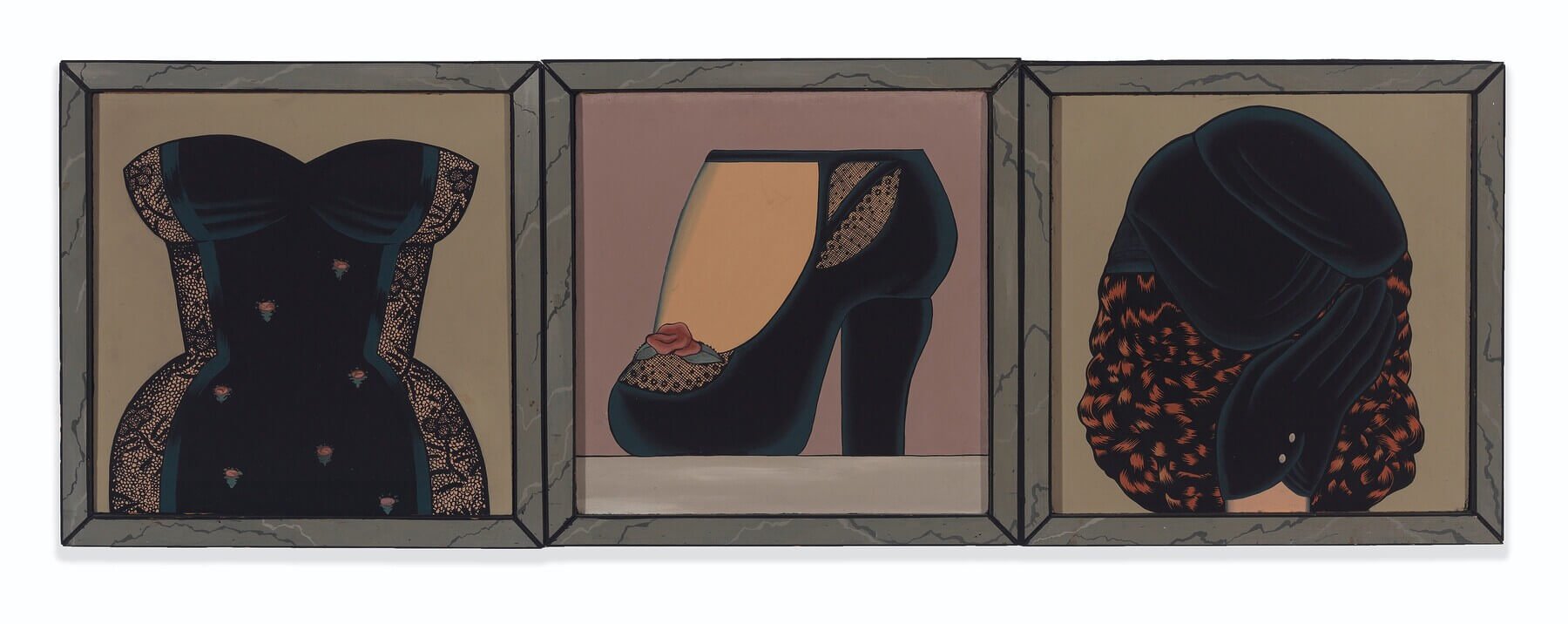
From the beginning then, her paintings were as much about what isn’t depicted as what is. Faces are absent, but so is narrative context. In a series of paintings from 1968, women’s hairstyles are seen from the back in closeup. These works are small—few are larger than ten by ten inches—and some are painted on Masonite panels that replace the glass in cheap tabletop mirrors. Manicured hands jut from the bottom or the edge of the frame to caress, coerce, or primp. But they can’t possibly belong to the women pictured; the angles are too skewed. The hands are interlopers, as dissociated as the swollen pumps or pinched corsets that are elsewhere the subjects of Ramberg’s attention. In a trio of untitled paintings from 1971, a bulbous, almost waterlogged, hand choreographs a white tissue into suggestive configurations. (One thinks of Magritte’s shrouded lovers or Kay Sage’s wrenched drapery.) Reading the trio sequentially, I can’t help but see it as an allegory of erotic conquest: the first image is all enveloping seduction; the middle is consummation, index finger pricking thumb, pinkie raised in erogenous oath; the final is postcoital entanglement and deflation.
The notion of voyeurism is embedded in such work. Ramberg’s figures are almost always pictured alone, intrusive hands notwithstanding, and often in a vulnerable state of undress, their heads covered. Implicit are questions of complicity and passivity, which is perhaps most directly broached in the aptly titled Waiting Lady (1972). Here, a woman in bra, panties, and stockings bends over, as if submitting to someone or something offstage, her head redacted by hair that has the silken languor of tossed lingerie. The image thrums with fetishistic vertigo. Who or what is the figure awaiting? Ramberg claimed, perhaps disingenuously, that her attraction to women’s undergarments was an innocent relic of childhood, when she watched her mother dress up for parties: “I used to think that this is what men want women to look like, she’s transforming herself into the kind of body men want. I thought it was fascinating. . . . In some ways, I thought it was awful.”
In Corset/Urns (1970), a work that advances serially across eight panels, Ramberg presents single variations on corsets, all of which are constructed of tightly disciplined hair. By the final frame, the meaning of the dialectical title is clear: the corsets mimic the voluptuous curves of funeral urns. A canned feminist interpretation sees a congruence between beauty standards and death, while a purely formal response has Ramberg lighting out for more metaphysical territory, into an exploration of the nature of ambiguity. The corset is at once a torso, a garment, a container, and an amalgam of all three. Works such as this echo Yoshida’s influence: “I’m interested in permutations of one idea or possible form, and, somehow, seeing them together in a group heightens their interest for me,” he once said.
In October 1973, Ramberg gave birth to a premature baby who died shortly after delivery. In two paintings that followed—Troubled Sleeve and Istrian River Lady (both 1974)—the torsos now extrude random tubers of hair. (The phallic connotations aren’t accidental; the paintings that precede these depict condom-like accoutrements called “ticklers.”) In Troubled Sleeve, the body appears to be swaddled in lacy bandages—a medicalized couture—and one arm ends in a stump. Even without knowing anything of Ramberg’s pregnancy, there’s a subtext of physical betrayal and malfunction. Whatever their coded psychological symbolism, these paintings clearly gesture toward the body’s treachery.
In the mid-1970s, Ramberg’s paintings became both larger and more oblique without losing any of their precision. Whereas her figures were once identifiably female, now they are androgynous armatures on which hair and netting are affixed in approximations of boudoir fashion. What was once lace is now chainmail. Fabric impersonates musculature. The sheen of hair is rendered with seismographic intensity, and inside the exposed armature are thrashed blades, as of dark grass or bristling weeds. There’s a quality of serration and hardness that contrasts with her earlier figures’ fleshiness. The paintings’ titles—Gloved, Wired, Glimpsed, Broken—convey the mood. All vestiges of the old voyeurism are gone. These models are full-frontal exhibitionists, even in the midst of what feels like creeping entropy.
By her 1975 painting Strung (for Bombois), named in honor of the French self-taught painter Camille Bombois, Ramberg strips figuration to the essentials: armature, taut fabric, and tufted hair, with swaths of negative space in between. Occasional thin wires bisect the form, hinting at a delicate tension, as if loosening even one stitch would dynamite the whole shebang. Ramberg’s elliptical purity presages rigorous discontinuity. In her next small series of works—of origami hats, chair backs, and table lamps—abstraction and figuration negotiate a faithless détente. Forms march to the brink of disintegration. Humanoid bodies resurface as self-contradictions, unable to contain anything except what’s external to them. Ramberg reflected in her diary: “Many times before I’ve thought about asymmetrical painting but have not been able to do one . . . I’m wanting to make pictures about . . . balance and [the] lack of it in human personality. Our souls are not symmetrical. We are not predictable from side to side.” In Schizophrenic Discovery and Hereditary Uncertainty (both 1977), the body is mismatched in rickety stasis. One half is clothed, however imperfectly, while the other half is bare scaffolding, splintered or uselessly ribbed. The figures look almost like mannequins dredged from a temperate dumpster.
In 1980, Ramberg and Hanson separated. In the paintings she made after, her figures are denser and more architectural. A recombinant logic impinges on the body—a spatial economy of pockets, envelopes, and secret chambers. Dwarfed bodies dangle from or adhere to the primary figures as if a wardrobe mutinied and reassembled itself into fussy rank. Ramberg synthesizes her previous motifs, the ornamental patterns, rogue hair, and subliminal armatures. Seeing these works hung together, it’s possible to appreciate them as a new tangent in Ramberg’s explorations, although for her, they must have felt like a retread of her greatest hits. In 1983, stymied by what she perceived as her art’s remoteness, she ditched painting altogether and turned her attention to quilt making, which she had done all along but now pursued single-mindedly. Even in this medium, Ramberg’s compositional verve all but blares. The quilts offered her freedom, as she told the Chicago Tribune in 1989:
[My quilts] are not separate from the tradition of quiltmaking . . . African-American quilts made throughout the South are the antithesis of the prissy, everything-has-to-match quilt. They’re the equivalent of jazz, they ignore the rules, they break the rules, and the result is some of the most exuberant things you’ve ever seen. Making these quilts taught me that you can do what you want, you don’t have to control everything.
Her allusion to giving up control was prescient. In 1989, Ramberg was diagnosed with Pick’s disease. It’s impossible to say how much her cognitive decline informed her haunting final series (she had resumed painting a couple of years earlier), but it’s tempting to see these works as metaphors for garbled communication. Their palette is a starkly monochromatic black and white. Masonite has been replaced by canvas, and the paint is scumbled and textural. Critics have described these late forms as satellites, and, indeed, the structures have a technical, even industrial, aloofness. During road trips, Ramberg sketched the lonely radio towers that often stalk a highway in the distance. These paintings are like schematics for such architectonic landmarks. One also recalls the austere water towers that the German duo Bernd and Hilla Becher photographed with devotion, or the colonnaded towers and rotundas that rise from Giorgio de Chirico’s deserted plazas. In these final paintings, Ramberg distills form to an almost hymnal essence. While the images aren’t conventionally beautiful and are more alienating than her earlier work, they remain as unshakeable as they are cryptic. Encountering them at the end of the exhibition is moving in ways that are hard to pin down. It’s like receiving news of a death you expected long ago.
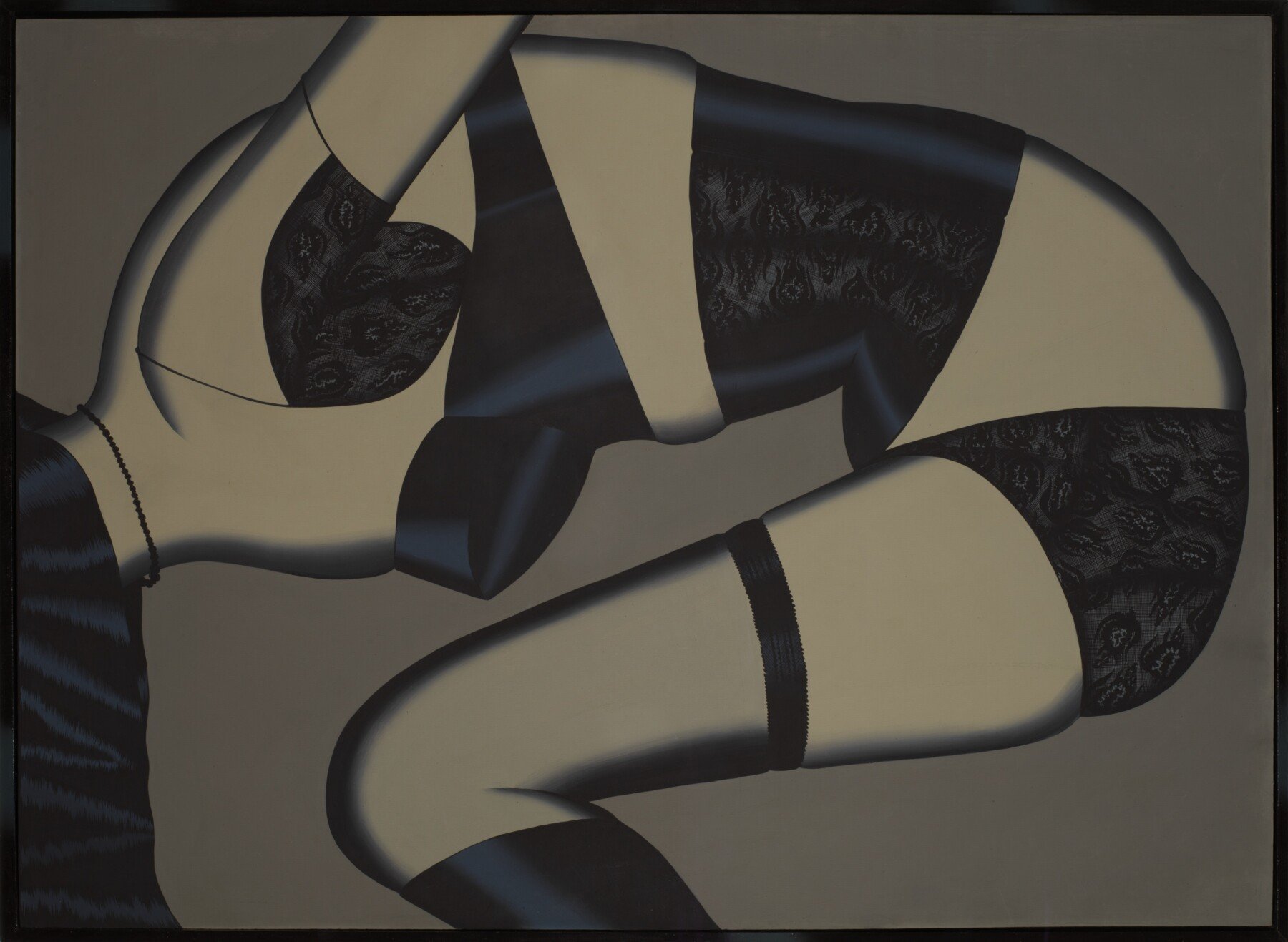
In something like a fairer world, Ramberg’s retrospective wouldn’t be so overdue. Her preoccupations have only grown more resonant with time, and a younger generation of artists—Julie Curtiss and Ewa Juszkiewicz, among others—are indebted to her achievements. Despite being often labeled proto-feminist, Ramberg exploits gender as a pretext rather than a thesis. She’s after something more universal and formally radical in her work; namely, a typology of our irreconcilable physical ambiguities and schisms. She’s a metaphysician of the body itself, with all of its seductions, handicaps, and corruption.
When Ramberg was teaching at the School of the Art Institute—where she became the chair of the painting and drawing department in 1985, the first woman to hold that title solo—she invited her students to imagine what a “comb that cannot untangle hair” looks like. What is an object once its primary function is denied? Now extend that idea to us poor sentient meat: What is a body that doesn’t cohere, that constrains itself or molts, that fractures?
There’s a paradox at the heart of Ramberg’s art. She speaks to specific differences while remaining a generalist. Perhaps that partly accounts for the timing of this retrospective in our identity- and marginality-drunk era. Ramberg’s art testifies on behalf of women, transgender people, those with disabilities, and queers of all stripes. But, also, she transcends essentialist categories to say something trenchant and disturbing about form itself—its malleability and its synonymity with our most intimate selves. You don’t look at her art so much as wait for its disclosures. Like the nun who dashed into that long hallelujah of flames, Ramberg knew to bite her tongue.



